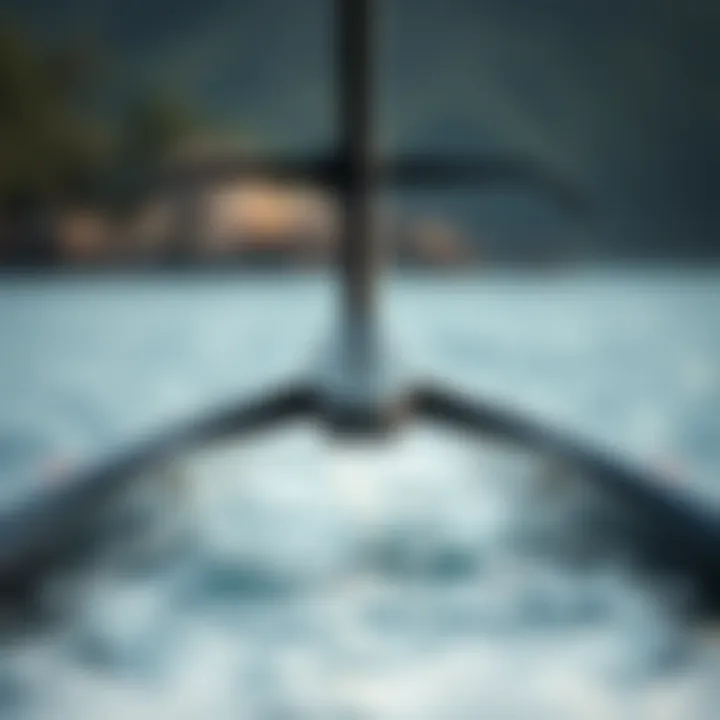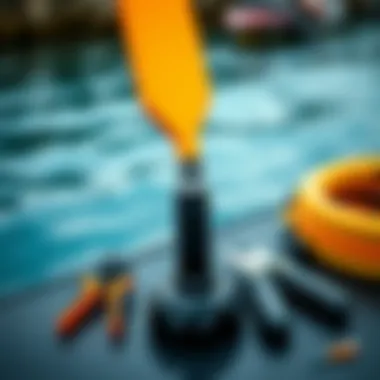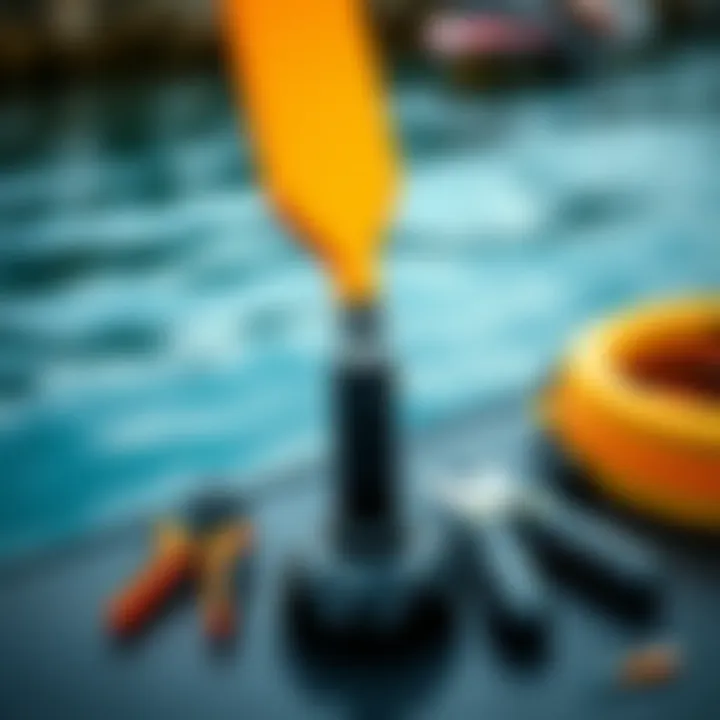Explore the Best Electric Hydrofoils for Watersports


Expert Insights
The rise of electric hydrofoils marks a significant transformation in the world of watersports. No longer confined to elite athletes or specialized locations, these dynamic crafts bring an inspiring blend of innovation and thrill to the average user. The water feels less like an obstacle, instead becoming a newfound playground where gravity's grip can be momentarily lost.
This segment will delve into the nuances of electric hydrofoils, highlighting their advantages, contemporary designs, and proper maintenance practices.
Latest Trends in Watersports
Electric hydrofoils are gaining traction, and for good reasons. With designs becoming increasingly sleek and user-friendly, enthusiasts ranging from novices to experts find joy in this evolution. The main trend centers on the integration of smart technology, where hydrofoils are not just about propulsion but also about connectivity. Imagine having a device that tracks your performance in real-time, allowing you to push your limits while ensuring safety.
Moreover, the influence of sustainable practices is becoming visible. Eco-friendly materials and energy-efficient motors are now commonplace, appealing to the environmentally conscious audience. This is more than just a fad; it's about ensuring a balance between thrill and planet preservation.
Safety Protocols and Best Practices
When exploring the world of electric hydrofoils, prioritizing safety is paramount. A few key protocols can transform your experience from daunting to exhilarating:
- Wear a Personal Flotation Device (PFD): Always ensure you have a comfortable, snug-fitting PFD before hitting the waves.
- Practice in a Calm Environment: Beginners should start in shallow and calm waters to minimize risk.
- Understand the Local Regulations: Every region may have specific guidelines or designated zones for hydrofoiling. Research these before you set out.
“Safety isn’t just a motto; it’s a mindset.”
Keeping your hydrofoil well-maintained is another vital aspect. Regularly inspect the battery life, pay attention to the foil's condition for chips or scratches, and ensure all electrical connections are clean and secure.
Equipment Recommendations
Investing in the right equipment makes all the difference. Proper gear not only enhances performance but also contributes to an enjoyable experience. Here’s a breakdown of essential and advanced gear.
Must-Have Gear for Beginners
For those just stepping into the electric hydrofoil scene, the list of essentials may include:
- Beginner-Friendly Hydrofoil: Models like Lift eFoil or Fliteboard are perfect for those new to this exciting sport. Their stable designs facilitate learning.
- Safety Gear: This should encompass a quality helmet and a buoyancy aid to promote safety while learning.
- Basic Maintenance Toolkit: Having tools on hand will assist in minor adjustments, ensuring you're always ready to ride.
Advanced Equipment for Pros
Once comfortable on the water, there lies an opportunity to advance one's experience with more sophisticated gear:
- High-Performance Hydrofoils: Brands such as Tacko or Waterfly offer options that permit substantial speeds and agile maneuvers, appealing to those interested in optimizing their performance.
- Performance Monitoring Devices: Investing in a device that tracks speed, distance, and battery life can help a rider refine techniques and set personal benchmarks.
Do remember that as you engage deeper into this adventure, continually updating your knowledge will not only keep you informed of the latest advancements but also improve your skills on the water.
For further insights, consider visiting resources like Wikipedia for fundamental knowledge or engaging with community discussions on platforms like Reddit for real-world advice and experiences.
Prolusion to Electric Hydrofoils
The exploration of electric hydrofoils marks a significant leap in watersports technology. Understanding electric hydrofoils isn’t just for industry insiders—it’s crucial for watersports enthusiasts who want to experience the best of what modern marine activity has to offer. The blend of innovative design, environmental consciousness, and performance-centric capabilities positions electric hydrofoils as a noteworthy alternative to traditional watercraft.
Defining Electric Hydrofoils
Electric hydrofoils combine a surfboard or a similar platform with a hydrofoil attached underneath that lifts it out of the water while in motion. This setup permits a smoother ride by reducing drag significantly. Think of it this way: when you ride a conventional surfboard, the board most often encounters resistance from the water surface, making the ride bumpy, especially in choppy conditions. On the other hand, an electric hydrofoil glides above the water once the necessary speed is reached, transforming the riding experience entirely. There's also an electric propulsion system that provides consistent acceleration, allowing riders to cruise without the usual paddling effort. Essentially, it’s like flying over the water rather than merely riding on it.
Historical Context and Evolution
Hydrofoiling dates back as far as the late 19th century, but the concept took root in mainstream watersports much later. The evolution accelerated in 2006, when the first production electric hydrofoil made waves in the market. Initially, they were met with skepticism, viewed by some as a novelty. Over the years, these boards have undergone vast improvement in design and technology.
The transition from gas-powered to electric propulsion reflects broader trends toward sustainability. With increasing concern about environmental issues, the adoption of electric hydrofoils illustrates this shift. As battery technology evolved, so did the performance and efficiency of these boards. Riders today can enjoy prolonged use without running out of juice mid-ride, a common concern just a few years back.
"The evolution of electric hydrofoils mirrors our commitment to a greener planet, while also amplifying the thrill of water-based sports."
How Electric Hydrofoils Work
Understanding how electric hydrofoils function is crucial for anyone looking to ride the waves with enhanced performance and efficiency. Electric hydrofoils operate on basic principles of physics combined with cutting-edge technology. The blend of lift and propulsion mechanisms creates a thrilling ride above the water's surface, allowing riders to glide effortlessly. The key to harnessing the full potential of an electric hydrofoil lies in understanding its mechanics and the technology behind its operation.
The Mechanics Behind Hydrofoiling
Lift and Drag Principles
At the heart of hydrofoiling, the relationship between lift and drag takes center stage. Lift is the force that elevates the board above the water, allowing it to reach an exhilarating speed with minimal resistance. When a hydrofoil moves through water, its shape forces the water to flow faster over the top than underneath, generating lift due to the difference in pressure. This feature is paramount because it allows riders to reach impressive speeds without excessive energy expenditure.
However, drag is an essential counterpoint; it is the resistance experienced as the board moves forward. A well-designed hydrofoil minimizes drag while maximizing lift, creating a balance that enhances performance. The ability to maintain this balance provides a beneficial experience for both seasoned enthusiasts and newcomers alike.
Benefits of Lift and Drag Principles:
- Improved speed with less effort.
- Stability at high speeds due to reduced drag.
Each hydrofoil model varies, with certain designs specifically focused on optimizing these principles for different water conditions. Adverse drag can be a rider’s worst enemy, therefore, choosing a hydrofoil with favorable lift-to-drag characteristics can significantly enhance the riding experience, making it an essential consideration in this article.
Hydrofoil Design Elements
Moving on to hydrofoil design, each element plays a vital role in how effectively a hydrofoil operates. The hydrofoil comprises the wing, mast, and fuselage. The wing is perhaps the most crucial part; its shape and size directly influence lift and drag. A larger surface area may create more lift but can also increase drag, which is something designers meticulously consider.
Mast length also influences the riding experience. A longer mast enables riders to glide above more turbulent waters, while a shorter mast might make it easier for beginners to control. Furthermore, the material of the hydrofoil affects its durability and weight, leading to a more responsive ride.
Key Characteristics of Hydrofoil Design:
- Wing Shape: Influences the hydrodynamic efficiency.
- Mast Height: Determines how smoothly the board rides over waves.
- Material: Affects both weight and strength, influencing overall control.
Finding the right hydrofoil design can impact both performance and user comfort. It's essential to choose one that aligns with your skill level and intended riding style. Selecting the right design elements makes a significant difference in creating a pleasant and thrilling experience, aligning perfectly with the audience’s needs in this article.


Battery and Propulsion Technologies
Electric Motors Overview
Electric motors are the powerhouse of an electric hydrofoil. They convert electrical energy from the battery into kinetic energy, propelling the hydrofoil forward. The efficiency of these motors has a direct connection to rider experience. High-performance electric motors are designed to deliver swift acceleration while maintaining a low noise level, contributing to the serenity of riding.
In general, brushless motors are popular choices. They provide robust performance without the mechanical complexities that might lead to maintenance issues. Reliability is key, and for avid riders, opting for a hydrofoil with a proven electric motor fits right into the goal of a seamless experience.
Key Features of Electric Motors:
- High Efficiency: More power for less battery consumption.
- Quiet Operation: Enhances the riding experience with less noise.
Electric motors can, however, vary in power output, affecting the maximum speed and acceleration capabilities. Enthusiasts must learn to gauge their preferences when selecting models, as variations can distinctly alter the riding experience, a crucial aspect discussed in this article.
Battery Types and Capacities
The battery type and its capacity play a pivotal role in how long and how fast riders can experience the thrill of hydrofoiling. The primary types of batteries seen in electric hydrofoils include lithium-ion and lithium polymer, each with its own characteristics. Lithium-ion batteries are favored for their longevity and efficiency, offering a good balance between weight and performance.
Battery capacity, measured in amp-hours (Ah), is critical as it determines how long riders can stay in the water before needing a recharge. Higher capacity batteries can provide more extended riding time, an essential factor for athletes seeking to maximize their time on the water.
Characteristics of Battery Types:
- Lithium-Ion: Well-known for longevity and lower maintenance needs.
- Capacity Measurement: Affects total riding time; crucial for planning sessions.
One must consider both battery type and capacity when choosing a hydrofoil. Selecting the right combination is a game-changer affecting performance and overall enjoyment, aligning with the thorough exploration theme of this article.
Understanding the mechanics and technology of electric hydrofoils sets a foundation for making informed choices in the world of watersports. With each component playing a critical role, riders can enhance their experience significantly by selecting thoughtfully based on their needs and preferences.
Benefits of Electric Hydrofoils
Electric hydrofoils present a myriad of advantages that are reshaping how enthusiasts engage with water sports. Beyond just the thrill, these hydrofoils harmonize performance with ease of use, making them an attractive option for both seasoned riders and newcomers stepping into this exhilarating world. The growing popularity of electric hydrofoils speaks volumes about their significant contributions to the overall water sports experience.
Performance Enhancements
Speed and Agility
A major draw of electric hydrofoils is their speed and agility. Riders often find themselves skimming smoothly above the water's surface, allowing for rapid acceleration that can turn a mundane outing into a heart-pounding adventure. The hydrofoiling concept eschews traditional drag-filled methods of propulsion; instead, riders can experience a fluid glide that feels almost otherworldly.
This unique design feature empowers riders to enjoy higher velocities without the cumbersome feeling of cutting through waves. Speed becomes not just an afterthought but a core component of the hydrofoil experience. Importantly, this agility contributes to heightened situational awareness, as riders may have a clearer view of their surroundings while flying above the waves.
Maneuverability on Water
When discussing electric hydrofoils, one cannot overlook maneuverability on water. This aspect allows for quick turns and precise navigation, enabling riders to dart around obstacles with ease. Such capability is particularly appealing when venturing in crowded waters or exploring new terrains.
With the ability to pivot on a dime, users can engage in complex tricks or simply navigate safely while enjoying leisurely rides. This responsiveness is often touted by athletes and recreationists, making it a highly regarded feature in any electric hydrofoil. The maneuverability not only enhances the fun but also amplifies safety—riders can adapt swiftly to sudden changes in the environment that might otherwise pose risks.
Environmental Considerations
Eco-Friendly Alternatives
In today’s environmentally conscious world, eco-friendly alternatives are paramount, and electric hydrofoils fit this bill nicely. Unlike traditional combustion-powered watercraft that spew harmful emissions, these electric options utilize clean energy to operate. This not only reduces the carbon footprint but also encourages a communion with nature that is both respectful and sustainable.
The electric engines consume significantly less energy and contain fewer harmful materials, marking a transition towards better choices in water sports. Moreover, this makes hydrofoiling appealing for those who prioritize sustainability without sacrificing the excitement of aquatic activities.
Noise Pollution Reduction
Another noteworthy aspect is noise pollution reduction. Many enthusiasts and casual riders have experienced the disruption loud engines cause, not just to their own pleasure but to the surrounding environment. However, electric hydrofoils operate with a whisper-quiet propulsion system, allowing users to glide across the water without disturbing the peace of nature or other water-goers.
The gentle hum of the electric motor provides a serene riding experience while maintaining the thrill of hydrofoiling. This aspect is particularly turning heads, especially in areas with strict noise regulations or for those who simply prefer quiet interactions with nature. With noise pollution kept to a minimum, riders can enhance their overall experience while nurturing a more peaceful environment.
Combining high performance with environmental responsibility, electric hydrofoils are not just a trend—they represent a thoughtful evolution in water sports.
Choosing the Right Electric Hydrofoil
Selecting the right electric hydrofoil is a crucial step for anyone looking to elevate their watersport experiences. With a myriad of options available in the market, understanding what to prioritize can save both time and money. It’s not merely about aesthetics or brand names; one needs to consider performance specs, durability, user-friendliness, and even personal riding style. By making informed choices, enthusiasts can maximize their enjoyment while minimizing frustrations.
Factors to Consider
Size and Weight
Size and weight stand as pivotal attributes when identifying the right electric hydrofoil. A lighter hydrofoil is generally easier to maneuver, which is beneficial for both novices and skilled users. If a hydrofoil is too hefty, it can make transport a hassle and may affect its performance on the water. Typically, smaller riders prefer lighter options, as it allows them to experience quicker responsiveness and lesser drag.
However, size is not a one-size-fits-all matter. Larger hydrofoils often provide greater stability, especially in choppy waters, making them essential for those who prioritize safety and ease over speed.
In summary, choosing the right size correlates closely with how one intends to use the hydrofoil – for speed racing or relaxed cruising.
User Experience Level
User experience level is a key factor when choosing an electric hydrofoil. A beginner might find a simpler model with fewer features more suitable, allowing them to master the basics without feeling overwhelmed. On the other hand, more seasoned riders likely look for high-performance models packed with advanced features, enabling maneuvers like jumps or sharper turns.
Each hydrofoil comes with its own learning curve, and understanding one's comfort level is paramount. A model that is too complex for a novice can lead to frustration, while an overly simplistic model may not satisfy an advanced rider's thirst for adrenaline.
Balancing the features with user experience is essential to ensure that riders can grow in their skills without feeling held back.
Comparative Analysis of Top Models


Performance Features
Performance features often dictate the overall thrill of riding an electric hydrofoil. When analyzing different models, factors such as speed, battery life, and stability are paramount. High-end hydrofoils exhibit superior acceleration, allowing users to hit higher speeds in a shorter time frame.
Crafts like the Lift eFoil have stood out in the market due to their powerful electric propulsion systems. The responsiveness of the controls plays a critical role in how well riders can manage their ride, especially in varying water conditions.
Ultimately, performance features should align with the user's intentions—whether for recreational use or competitive racing.
Price Points and Value
Price points and value are frequently intertwined when it comes to electric hydrofoils. It’s tempting to go for the most affordable option, but often, lower-priced models compromise on durability or performance. Conversely, investing in a top-tier model like the Fliteboard can seem daunting but often pays off in the long run due to its reliability and performance.
The value of a hydrofoil is not solely determined by its price tag. Understanding what features align with your riding goals can transform a costly investment into a wise choice. It’s about finding that sweet spot where quality meets functionality, ensuring long-term satisfaction ride after ride.
"Choosing the right electric hydrofoil is like picking the right tool for the job. A well-chosen model can enhance not just your performance but your overall enjoyment on the water."
By considering these factors—size and weight, user experience level, performance features, and price points—you're one step closer to making a decision that suits your personal needs on the water. The next wave of aquatic thrills awaits you with the right electric hydrofoil.
Top Electric Hydrofoils in the Market
Understanding the top electric hydrofoils available today is crucial for both novices and seasoned watersports enthusiasts. The right hydrofoil can elevate your experience on the water, promoting not just enjoyment but also safety and efficiency. Each model brings its own set of benefits, making it important to delve into reviews and user feedback thoroughly. The following sections aim to provide insights into various brands and models currently making waves in the industry, emphasizing what sets them apart in terms of performance, design, and user satisfaction.
Model Reviews
Brand A Overview
Brand A is recognized for its innovation and cutting-edge technology. One prominent model exemplifying this is the Series X, known for its impressive stability and ease of use, which makes it a favored choice for beginners. Its lightweight construction significantly enhances maneuverability while not compromising on durability.
A unique feature of the Series X is its adjustable hydrofoil wings. This adaptability allows riders to customize the lift based on personal preference and water conditions. While this versatility is a major draw, some users have pointed out that it could take time to find the ideal settings. Such heightening of customization can be daunting for new riders who may prefer a more straightforward setup.
Brand B Overview
Brand B stands out in the market due to its emphasis on speed and agility. The Volt 500 model exemplifies this focus with its powerful motor and streamlined design. It's particularly appreciated by experienced riders seeking high performance and responsiveness.
The key characteristic of the Volt 500 is its high top speed, which can reach up to 30 km/h. However, while speed can be thrilling, it demands a higher skill level to handle effectively, limiting its accessibility to less experienced riders. Additionally, its battery life may not outlast a full day on the water, leading to consideration for frequent charging.
Brand Overview
Brand C has carved out a niche by targeting eco-conscious riders with its GreenFoil model. This hydrofoil incorporates sustainable materials and offers an eco-friendly alternative without skimping on performance. The emphasis on environmentally responsible production resonates with a growing community among users seeking to lessen their carbon footprint while enjoying water sports.
One of the standout features of the GreenFoil is its quiet operational noise. This allows for a serene riding experience, especially appealing for those on quieter bodies of water. However, some critiques suggest that it might not provide the level of speed that performance enthusiasts look for; the balance between eco-friendliness and raw power can sometimes feel skewed.
User Ratings and Feedback
Common Praise
Across various platforms, users commend electric hydrofoils for their intuitive handling and ease of use. Many individuals have noted that the learning curve is surprisingly manageable, with several models enabling quick acclimatization to hydrofoiling. The instant lift experienced as riders rise above the water surface also garners significant admiration, creating a thrilling sensation that many describe as both exhilarating and liberating.
Unique to this praise is the responsive customer service provided by brands, where users often find themselves supported during their learning journey. This level of service adds an extra layer of comfort in trying something new.
Critiques and Limitations
Despite the overall positive feedback, certain critiques emerge consistently across models. One persisting concern involves battery life, where many users express dissatisfaction with how long they can ride before needing a recharge. This limitation can hinder spontaneous outings, particularly for those who wish to spend a full day on the water.
Moreover, performance variations based on water conditions have been highlighted in discussions. Rougher waters can significantly impact stability, leading some users to question the versatility of their selected model. Addressing these limitations often requires additional investment in equipment or maintenance care, which can be a deterrent for budget-conscious adventurers.
"Electric hydrofoiling combines adrenaline with tranquility, but understanding the nuances of each model can be the difference between an unforgettable ride and a frustrating experience."
Exploring the top electric hydrofoils on the market situates potential buyers at a unique intersection of performance, sustainability, and innovation. Achieving the right balance often requires delving deeper into model specifications and user reviews, thus taking the guesswork out of the decision-making process.
For more insights about electric hydrofoils and updates in technology, visit Wikipedia or look for community discussions on Reddit.
Maintenance and Care for Electric Hydrofoils
Maintaining and caring for electric hydrofoils is crucial for ensuring their longevity and optimal performance. Just like any gear or equipment, neglecting maintenance can lead to a decline in functionality and safety. This section delves into the necessary routine care that owners should adopt, focusing on battery management and cleanliness, which ultimately enhance the riding experience.
Routine Maintenance Tasks
Battery Care
Taking care of the battery is paramount. This power source is what keeps the hydrofoil gliding through the water, and its management directly affects performance. A charged battery might seem like a small thing, but it’s the heart of the device.
One of the key characteristics of battery care includes regular charging practices. Batteries should be charged as per the manufacturer's instructions and often need to be topped off after use to maintain their lifecycle. It's also vital to store batteries at the recommended voltage level to avoid deep discharging, which significantly reduces battery life.
A unique feature about many hydrofoil batteries is their integrated battery management systems. These systems monitor battery health, ensuring safe operation. The advantage? Riders can enjoy longer rides without worry. However, a downfall is that these systems can be complicated for users not well-versed in tech, sometimes leading to unnecessary confusion.
Cleaning and Inspections
Cleanliness goes a long way in prolonging the life of electric hydrofoils. Regular cleaning helps avoid salt and debris buildup, which can impair performance. A key consideration is that hydrofoils have various exposed parts that can corrode if neglected.
Regular inspections are another critical aspect. Inspecting for wear and tear not only helps maintain efficiency but also identifies potential problems before they escalate. One unique feature here is the accessibility of most components, which means many riders can handle routine checks without needing professional help. The advantage here is significant savings on potential repair costs. However, inspections do require a bit of time and attention, which some users might overlook amidst their busy schedules.
Troubleshooting Common Issues
Electrical Problems
When it comes to electric hydrofoils, electrical issues can be a thorn in the side. These problems can be anything from faulty wiring to more complex electronic control failures. Understanding the layout and particular components of your hydrofoil helps you tackle these issues effectively.
A crucial characteristic of electrical problems is unpredictability; they can arise without warning, impacting enjoyment and safety. Regular care and checks help mitigate risks, ensuring the equipment is in peak condition. If problems arise, referring to the manual for troubleshooting guidance is often a beneficial step to resolving issues swiftly.
Performance Drops
Experiencing a drop in performance can be disheartening. Whether it’s a sudden issue with speed or agility on the water, identifying the cause is essential for maintaining a quality experience. Possible culprits could include low battery charge, drag from dirt or debris, or mechanical failures.
The unique feature of performance drops is that they can often be rectified simply through cleaning or recharging the battery. The key here is not to ignore warnings of decreased efficiency. Tackling these issues promptly can save you from more significant headaches down the road. While performance drops are somewhat common, the fix is often straightforward, allowing riders to get back on the water faster.


Regular maintenance not only fosters a better riding experience but also extends the life of your electric hydrofoil. A little care goes a long way.
Safety Considerations and Best Practices
When engaging with electric hydrofoils, safety is paramount. Given the unique mechanics and speed capabilities of these watercraft, adhering to safety considerations can serve as a safeguard against potential mishaps. From personal protective equipment to understanding waterway regulations, adopting best practices can enhance not just your experience but also that of those around you.
Essential Safety Gear
Life Jackets
Life jackets play a crucial role when kiteboarding or sailing on an electric hydrofoil. Ensuring they are coast guard approved and fitting snugly is essential. A life jacket provides buoyancy, which can be lifesaving during unexpected falls into the water. Some models even come equipped with additional features such as pocket systems for storing essentials while you ride. However, it is worth considering that bulky life jackets can restrict your movement, which may impact agility while navigating the waters.
- Key Characteristic: Buoyant and floatation-enhancing features.
- Unique Feature: Additional pockets for storage.
- Pros/Cons: Essential for safety, yet may inhibit movement slightly.
Helmets and Other Gear
Helmets are often overlooked in the excitement of hydrofoiling. Yet, wearing a helmet can significantly reduce the risk of head injuries from falls or collisions. A good helmet has an impact-absorbing design, which enhances protection without being too cumbersome. Some helmets even come with integrated visors to shield against sun glare, improving visibility when riding. While helmets can seem like an unnecessary hassle to some, the peace of mind they provide is irreplaceable, especially for beginners.
- Key Characteristic: Impact-resistant with adjustable fittings.
- Unique Feature: Integrated visors for better visibility.
- Pros/Cons: Vital for head safety but may feel awkward initially.
Navigating Waterways
Understanding Local Regulations
Understanding local regulations before hydrofoiling in any area is not just a matter of adhering to the law but a fundamental aspect of ensuring safety. These rules can dictate everything from speed limits to designated zones for foiling, which helps prevent accidents and conflicts with other water users. Staying informed about these regulations can also foster a better relationship with other enthusiasts and local authorities.
- Key Characteristic: Codified guidelines for waterway usage.
- Unique Feature: Different regulations apply in varied geographical areas.
- Pros/Cons: Encourages responsible riding, can be tedious to research.
Avoiding Hazards
In the realm of electric hydrofoiling, avoiding hazards is critical for a safe ride. This includes steering clear of underwater obstacles, strong currents, or crowded areas where collisions can easily occur. Implementing a constant state of awareness while navigating waterways will greatly enhance safety. With time, riders develop an instinct for spotting potential risks that lie ahead, enabling more responsive decision-making.
- Key Characteristic: Proactively scanning for dangers in the environment.
- Unique Feature: Familiarity with common local hazards.
- Pros/Cons: Heightened safety awareness, requires attentiveness and skill.
Engaging in electric hydrofoiling can be thrilling, but embracing safety gear and adhering to local rules transforms the experience from risky to enjoyable. Be proactive in understanding the landscape – both in terms of regulation and environment.
The Future of Electric Hydrofoiling
As we peer into the horizon of electric hydrofoiling, it’s clear that this thrilling mode of water transport is all set for a transformation. The popularity of electric hydrofoils has surged, driven by advancements in technology and emerging trends in design. Recognizing what’s in store isn’t just for the aficionados but also essential for anyone looking to stay ahead of the curve in this evolving sport. From the improvements we expect in battery energy systems to the folding of new-age designs that optimize performance, these future paths highlight how electric hydrofoiling can continue to bridge the gap between adrenalin and sustainability.
Innovations on the Horizon
Advancements in Battery Technology
The heart of any electric vehicle, and by extension, electric hydrofoils, lies in its battery. The next big leap in battery technology often revolves around improvements in energy density and charging speed. Lithium-sulfur and solid-state batteries are being explored for their potential to outperform the current lithium-ion systems. Not only do they promise longer rides with less downtime, but they also reveal an intriguing characteristic: reduced weight. This becomes a game-changer for performance, as lighter batteries can lead to faster hydrofoiling experiences.
Battery life is pivotal for enthusiasts who wish to maximize their time on the water. Advances in this field may see hydrofoils lasting longer on each charge, which would be a boon for both professional athletes and weekend warriors alike. However, these advancements might come with disadvantages, such as increased costs or challenges in manufacturing scalability.
New Design Trends
When it comes to design, electric hydrofoils are not just functional; they are also becoming more aesthetically appealing. Recent trends show a push towards minimalist designs that incorporate sustainable materials. This isn’t merely about looks; it’s about functionality married with environmental consciousness. Manufacturers are exploring lightweight composites and sustainable woods that enhance buoyancy without sacrificing durability.
A noteworthy feature of these new designs is modularity, enabling users to swap out parts easily. This design trend offers riders the flexibility to customize their board according to their needs, be it for speed or stability. However, a potential downside is the reliance on consistent high-quality production that can sometimes be compromised during scale-up.
The Growing Community of Enthusiasts
Social Media Influence
Social media serves as a catalyst for the growth of the electric hydrofoiling community. Platforms like Instagram and TikTok allow enthusiasts to share their experiences and breathtaking rides, bringing this sport into the spotlight. Videos of electric hydrofoil antics often go viral, encouraging more people to join in. The tagging and sharing culture foster connections among riders and even lead to challenges and virtual competitions, creating a sense of community.
The interactive nature of social media means that potential buyers can see the real-world performance of products before making a purchase, which is certainly advantageous in an age where consumers seek authenticity. Yet, a flip side exists too; unrealistic portrayals can sometimes mislead newcomers into underestimating the learning curve involved in mastering hydrofoiling.
Event and Community Gathering Trends
The electric hydrofoiling community is not confined to online interactions. There has been a notable rise in events dedicated to this sport, with gatherings taking place globally. From competitions organized by brands to informal meet-ups, these events create opportunities for enthusiasts to share tips, showcase gear, and engage in friendly competition. One distinctive feature? The diverse age range of participants, from young thrill-seekers to seasoned water sports veterans.
These events often highlight innovation through testing new products directly in the water, allowing participants to experience first-hand what the industry has to offer. However, it’s important to mention that not every gathering is easily accessible, which could limit participation for those in less populated regions.
Closure: Embracing the Electric Hydrofoil Experience
As we wrap up this exploration into electric hydrofoils, it's essential to reflect on the myriad of benefits these innovative crafts bring to the world of water sports. Electric hydrofoiling is not just a fleeting trend; it embodies a significant leap in technology and design that redefines our relationship with water. By harnessing the dynamics of lift and drag, coupled with advancements in battery technology, these devices transform how we experience rides on the water.
Summarizing Key Takeaways
Electric hydrofoils usher in a new era of aquatic adventure, marrying performance with sustainability. To distill the key insights from our discussion:
- Superior Performance: The ability to glide above water minimizes drag and maximizes speed, giving a thrilling ride unlike any traditional watercraft.
- Eco-Conscious Ownership: With the increasing concern for environmental impact, the shift towards electric propulsion in hydrofoils resonates well with eco-friendly practices, reducing emissions and noise pollution.
- Ease of Use and Accessibility: The growing variety of models caters to all skill levels, making hydrofoiling more accessible for newcomers while still challenging for seasoned riders.
- Community and Culture: Engaging with fellow enthusiasts enhances the experience, fostering a spirit of camaraderie that is vital for any sport.
Moreover, as innovative designs continue to emerge, users will discover a vast array of features tailored to enhance their aquatic experiences, from battery life to customizable setups.
Encouraging Exploration and Learning
Getting started with electric hydrofoils might seem daunting, but the rewards are rich for those who venture into this thrilling domain. As with any sport, knowledge is power. Here are some pathways to dive deeper:
- Join Online Communities: Platforms like Reddit offer forums for discussion, where newcomers can glean insights from experienced riders. Engaging in these spaces fosters a sense of belonging and shared passion.
- Workshops and Training: Many retailers and local clubs provide hands-on training to help users acclimate to hydrofoiling. Participating in these activities not only enhances skills but also builds foundational confidence.
- Stay Informed: Keeping abreast of the latest technology and trends in electric hydrofoiling is crucial. Websites such as Wikipedia and Britannica provide curated information on the science and advancements that define this exciting field.
In essence, embracing the electric hydrofoil experience is about more than just mastering a new craft; it's about becoming part of an evolving community that cherishes innovation, adventure, and a profound connection with nature. So, whether you're a curious newcomer or a seasoned pro, there's always more to discover. Now, go out there, catch some wind, and ride the waves!
"The best way to predict the future is to create it."
This quote rings true in the electric hydrofoiling scene. By actively participating, you contribute not just to your own adventure but to shaping the industry's future, one ride at a time.







